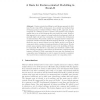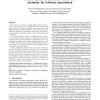429 search results - page 70 / 86 » Scoping software product lines |
ICSE
2005
IEEE-ACM
14 years 7 months ago
2005
IEEE-ACM
Design for change is a well-known adagium in software engineering. We separate concerns, employ well-designed interfaces, and the like to ease evolution of the systems we build. W...
EICS
2009
ACM
14 years 2 months ago
2009
ACM
Usability-supporting architectural patterns (USAPs) were developed as a way to explicitly connect the needs of architecturally-sensitive usability concerns to the design of softwa...
ASM
2010
ASM
14 years 2 months ago
2010
ASM
Abstract. Feature-oriented modelling is a well-known approach for Software Product Line (SPL) development. It is a widely used method when developing groups of related software. Wi...
ASPLOS
2010
ACM
14 years 2 months ago
2010
ACM
In this paper we evaluate the atomic region compiler abstraction by incorporating it into a commercial system. We find that atomic regions are simple and intuitive to integrate i...
DSRT
2005
IEEE
14 years 1 months ago
2005
IEEE
Engine production is a complex process that requires the manufacturing and assembly of a wide variety of components to create a varied product mix. Simulation plays a key role in ...


